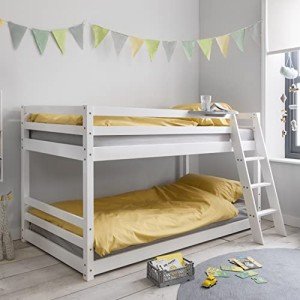The 9 Things Your Parents Taught You About Bunk Bed
A Comprehensive Guide to Children's Bunk Beds: Styles, Benefits, and Safety Considerations
Bunk beds have actually become a popular choice for families wanting to optimize space and supply a fun sleeping environment for children. With their unique design, they use an innovative and useful option for shared bedrooms, playrooms, or even guest accommodation. This post explores the different styles of children's bunk beds, their benefits, safety factors to consider, and answers some frequently asked concerns.
The Allure of Bunk Beds
Kid's bunk beds are more than simply space-saving structures; they are likewise a gateway to daring dreams and creative play. Below is an in-depth examination of their various benefits.
Benefits of Bunk Beds
- Space-Saving: Bunk beds efficiently utilize vertical space, making them an ideal choice for smaller rooms.
- Lively Design: Many bunk bed styles include slides, tents, and themed aspects, sparking creativity and enjoyment.
- Partner Sharing: Bunk beds are best for brother or sisters sharing a space or accommodating sleepovers.
- Versatile Use: Some models can be separated into two individual beds, using versatility as kids grow.
- Storage Options: Many bunk beds come with integrated drawer storage or shelves, further enhancing their practicality.
Designs of Children's Bunk Beds
The range of bunk beds available today deals with various choices and needs. Below is an introduction of some popular styles.
Design
Description
Best For
Requirement Bunk Bed
A traditional design featuring one bed stacked above another.
Siblings sharing a space.
Loft Bed
Similar to a bunk bed without the bottom bunk, permits for a work space or play location listed below.
Limited space for play/desk.
L-Shaped Bunk Bed
2 beds set up in an L-shape, frequently with additional areas for storage or play.
Special room layouts.
Twin Over Full
A twin bed over a complete bed, accommodating different sleep requirements.
Growing kids and teens.
High Sleeper
Stands even greater than a loft bed, typically featuring a desk or play location below.
Older kids requiring more play/desk space.
Tent Bunk Bed
Bunk beds with a canopy or tent-like structure, creating a comfortable, enjoyable space.
Active and creative kids.
Key Features to Consider
When choosing the ideal bunk bed for children, the following features are worth considering:
- Material: Bunk beds can be made from wood, metal, or a combination. Bunk Beds Sales has its unique aesthetic and sturdiness.
- Weight Capacity: Always verify the weight limitation of the bunk bed to ensure it can accommodate your kids securely.
- Safety Rails: Ensure the leading bunk has sturdy rails to avoid falls.
- Ladder Security: A properly designed ladder ought to offer easy and safe access to the upper bunk.
- Completing: Ensure any finishes are non-toxic and safe for kids.
Safety Considerations
Safety is vital when it concerns children's bunk beds. The following standards ought to be stuck to:
- Age Appropriateness: Generally, kids under six years old need to not oversleep the upper bunk due to security dangers.
- Tough Construction: Ensure the frame and products are solid and can support the weight without drooping.
- Regular Maintenance: Periodically inspect for loose screws, bolts, or other elements that may require tightening up.
- Clear Play Area: Keep the location around the bunk bed complimentary of toys and challenges to decrease tripping hazards.
Setting Rules for Safe Use
Establishing standards for bunk bed use will assist guarantee security:
- Limit Jumping and Climbing: Children need to be encouraged against leaping from the leading bunk and getting on the sides.
- Supervising Sleepovers: Monitor young visitors while they are utilizing the bunk bed for the very first time.
- Educate on Ladder Use: Teach how to utilize the ladder safely, emphasizing the value of facing the ladder when climbing or down.
Frequently Asked Questions
1. What age is appropriate for a child to oversleep the leading bunk?
Most makers advise that kids ought to be at least six years of ages to sleep in the upper bunk. This standard is developed to alleviate the risk of falls.
2. Can bunk beds be tailored?
Yes, lots of producers use customizable choices, including colors, products, and extra functions like drawers or desks.
3. Are bunk beds safe for weight?
Bunk beds have weight limits, normally ranging from 200 to 400 pounds, depending upon the model and material. Always inspect the producer's specs.
4. How do I maintain and clean a bunk bed?
Regularly look for loose parts, keep the bed clean by cleaning down surfaces, and make sure the bed linen is fresh to promote a safe and hygienic sleep environment.
5. Can bunk beds be separated into private beds?
Lots of bunk beds come with an option to separate them into 2 specific beds, offering long-term flexibility.
Kid's bunk beds are more than mere furniture; they are a functional, versatile, and creative element of a child's room. With various styles offered and many security factors to consider to bear in mind, parents can select the best bed that fits their space, meets their children's needs, and imparts a sense of adventure. By understanding the advantages, designs, and precaution related to bunk beds, households can create a wonderful and safe sleeping environment for their kids. Whether for brother or sisters sharing a space or space-saving solutions, bunk beds stay a precious option for numerous households.
